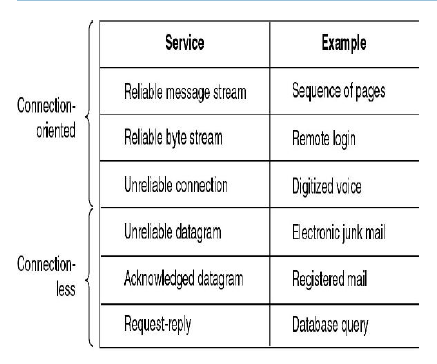• Not a network architecture,
because it does not specify the exact services and
protocols to be used in each
layer, it just formally defines and codifies the concept
of layered network architecture
• Each layer describe what
happens at each stage in the processing of data for
transmission
• Layers help to reduce
complexity
• Each layer relies on the next
lower layer to perform more primitive functions
• Each layer provides services to
the next higher layer
• Changes in one layer should not
require changes in other layers
The functions of
different layers
Physical
• responsible for transmitting
raw bits over a communication path
• concerned with issues such as
-mechanical interfaces, e.g.
design of a network connector
-electrical interfaces, e.g.
voltage level of bits
-procedural interfaces, e.g.
whether transmission may
proceed simultaneously in both
directions
Data Link
• Responsible for the transfer of
data between the ends of a physical link
• Provides for error detection,
"framing", and flow control
• Resolves problems due to
damaged, lost, or duplicate frames
• Formatted messages are referred
to as frames rather than packets
Network
• Responsible for the source to
destination routing
• Addresses and resolves all
inherent problems related to the transmission of data
between heterogeneous networks
• Formatted messages are referred
to as packets
• In broadcast networks the
network layer is often thin or nonexistent, because of
easy to solve routing problems
• Sometimes no need for a network
layer if using point-to-point link
Transport
• Provides for error-free
delivery of data
• Accepts data from the session
layer and splits data into smaller packets if
necessary
• passes these packets to the
network layer, and ensures that packets arrive in
sequence, with no losses or
duplications, at their destination
Session
• Provides for coordination
between communicating processes between nodes.
• Manages dialog control (e.g.
Can allow traffic to go in both direction at the same
time, or in only one direction at
time.)
• Responsible for synchronizing
the flow of data, and reestablishing a connection
in the event a failure occurs.
Presentation
• Provides for data formats, and
code conversions
• Concerned with syntax and
semantics of data being transmitted
• Encodes messages in a form that
is suitable for electronic transmission
• Data compression and encryption
is done at this layer
Application
• Consists of protocols that
define specific user-oriented applications such as email,
file transfer, and virtual terminal
Notes
Differences between a computer
network (CN) and a distributed system(DS)
• CN collection of computers
connected by single technology
• DS collection independent
computers appears as one coherent system
• Middleware responsible for the
DS
• WWW is the example of DS
• DS software system built on top
of network
The two services a network offers
Connection
oriented
• A connection is established
between ES’s (end System) that is used for duration
of call
Call setup
Data transfer
Call termination
E.g: Virtual circuits at this
layer
• IS’s ( intermediate system)
connect two or more networks
IS appear as ES to each network
Logical connection set up between
ESs
-Concatenation of logical
connections across networks Individual network virtual circuits
joined by IS
• Advantages
– Fixed path
– Order of message preserved
– No loss of data
• Reliable
– But the process of
acknowledgement adds overhead and delay
– Example: telephone, ftp
Connectionless
• Each packet sent independently
• Routing decisions made at every
IS
• Corresponds to datagram service
in packet switched network
• Network layer protocol common
to all ES’s and routers
– Known generically as the
internet protocol
• Internet Protocol
– One such internet protocol
developed for ARPANET
– Example: Telegraph systems,
email, remote login
– Advantages
– Flexibility
– Robust
– No unnecessary overhead
– Unreliable
– Not guaranteed delivery
– Not guaranteed order of
delivery
– Packets can take different
routes
– Reliability is responsibility
of next layer up (e.g. TCP)
The following table shows an example of 6 different
services







0 comments